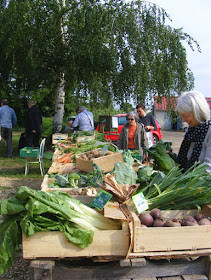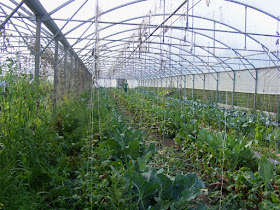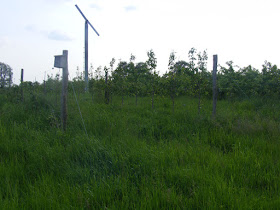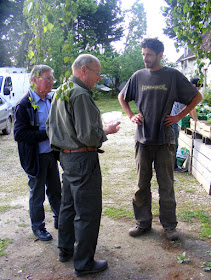On Saturday 26 May the Association de Patrimoine Vivant de la vallée de la Claise (PVCT) organised an outing to see some sundials, led by Joël Rodenburger. The meeting place was the lane up to a hamlet called les Bienneries (an old word for 'well behaved', so literally, 'the goodies').
Looking at the sundial in Les Bienneries.
We have English friends, Ceri and James, who have a house there, but we didn't think they were in town so I failed to email them to say we'd be in the vicinity. Imagine our amusement when it turned out that not only was James home, but the sundial we'd come to see was on his house!
The sundial at Les Bienneries.
It's a rather splendid oval shaped one carved out of the local limestone, with an inscription 'PAX HVIC DOM' ('peace upon this house') and dated 1634. Separating the centuries and the decades is a cartouche with a double V and a heart motif. This decorative addition is an exhortation to 'live!' It is apparently traditional to have some sort of aphorism or motto inscribed on sundials.
Joël informed us that this is a classic vertical sundial, facing south. To tell the time, the style should be set at an angle of 90° less the latitude, however it's in rather poor condition, so it isn't accurate anymore.
Looking at the Charnizay canonical sundials
(which no longer function because they predate the big 15th century buttresses).
In the first half of the 17th century there weren't many instruction manuals for sundials and the Bienneries one is a relatively simple design, possibly achieved by trial and error. It is the oldest true sundial in Indre et Loire. Joël speculated that it was created by an itinerant sundial maker who was also a journeyman mason or stone cutter, on his Tour de France (a journey undertaken to gain experience with different master craftsmen all around the country).
Sundials on the church at Charnizay.
After a very welcome drink served by James we moved on to the church in Charnizay. Here, on the south facing exterior wall are the remnants of four canonical sundials (only one of them still clear). The purpose of these is not for the general public to tell the time per se, but for the priest to know when to perform the daily cycle of services. They date from the Middle Ages, maybe the 12th century. They are semi-circles, divided into six, eight or twelve sectors and vary according to the season. When they were etched into the wall the church only had small buttresses, but nowadays the sundials are in the shade of more massive buttresses added in the 15th century.
The group moved on to see a modern sundial which had been erected by the former owner at La Ferme de la Petite Rabaudière. The organic market garden and orchard is now owned by Sylvain and Tony and I was a bit sorry not to be popping in to see them, but I'm afraid we skived off and went and visited Niall and Antoinette instead.


















































